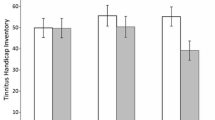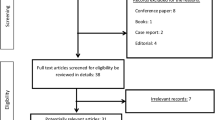Abstract
Tinnitus is usually associated with different comorbidities such as anxiety, annoyance and depression. Evidences have targeted two main places for tinnitus treatment, namely the auditory cortex and the dorsolateral prefrontal cortex (DLPFC). Transcranial direct current stimulation (tDCS) has been reportedly associated with improvement of cognitive functions in individuals. This study was conducted to evaluate the therapeutic effects of repeated sessions of anodal bifrontal tDCS on tinnitus symptoms. Furthermore, the tDCS impacts on the comorbid depression and anxiety of the patients were investigated. Forty-two voluntaries that suffers from chronic tinnitus were randomly assigned into “real tDCS” (n = 21) and “sham tDCS” (n = 21) groups. The tDCS group, received tDCS with the protocol consisted of 2 mA current, daily one session of 20 min, 6 consecutive days per week and for 4 consecutive weeks. The tinnitus handicap inventory (THI) scale, was measured before the first tDCS session and at one-week and two weeks follow-up. With the same intervals; the distress-related tinnitus was evaluated using visual analogue scale. Depression and anxiety scores were also measured using the Beck depression inventory and Beck anxiety inventory scales, respectively. Our findings indicated that THI score, depression and anxiety level has been gradually diminished across subsequent measurement intervals. We also find significant reduction of distress-related tinnitus in the real-tDCS group after treatment. We conclude that application of tDCS to the bilateral DLPFC region alleviates chronic tinnitus and it should be considered in patients with refractory tinnitus.

Similar content being viewed by others
References
Scott B, Lindberg P (2000) Psychological profile and somatic complaints between help-seeking and non-help-seeking tinnitus subjects. Psychosomatics 41(4):347–352
De Ridder D, Elgoyhen AB, Romo R, Langguth B (2011) Phantom percepts: tinnitus and pain as persisting aversive memory networks. Proc Natl Acad Sci USA 108:8075–8080
Chan Y (2009) Tinnitus: etiology, classification, characteristics, and treatment. Discovery Med 8(42):133–136
De Ridder D, Fransen H, Francois O, Sunaert S, Kovacs S, Van De Heyning P (2006) Amygdalohippocampal involvement in tinnitus and auditory memory. Acta Otolaryngol 126(sup556):50–53
Eggermont JJ, Roberts LE (2004) The neuroscience of tinnitus. Trends Neurosci 27:676–682
Schaette R, Kempter R (2006) Development of tinnitus-related neuronal hyperactivity through homeostatic plasticity after hearing loss: a computational model. Eur J Neurosci 23(11):3124–3138
Langguth B, Eichhammer P, Kreutzer A, Maenner P, Marienhagen J, Kleinjung T et al (2006) The impact of auditory cortex activity on characterizing and treating patients with chronic tinnitus–first results from a PET study. Acta Otolaryngol 126(supl 556):84–88
Roland LT, Peelle JE, Kallogjeri D, Nicklaus J, Piccirillo JF (2016) The effect of noninvasive brain stimulation on neural connectivity in tinnitus: a randomized trial. Laryngoscope 126(5):1201–1206
Yadollahpour A, Jalilifar M, Rashidi S (2017) Transcranial direct current stimulation for the treatment of depression: a comprehensive review of the recent advances. Int J Mental Health Addic. 2017:1–10
Bation R, Poulet E, Haesebaert F, Saoud M, Brunelin J (2016) Transcranial direct current stimulation in treatment-resistant obsessive compulsive disorder: an open-label pilot study. Progress Neuro-Psychopharmacol Biol Psych 65:153–157
D’Urso G, Brunoni AR, Anastasia A, Micillo M, de Bartolomeis A, Mantovani A (2016) Polarity-dependent effects of transcranial direct current stimulation in obsessive-compulsive disorder. Neurocase 22(1):60–64
Mirmomeni G, Nikakhlagh S, Saki N, Bayat A (2018) Transcranial direct current stimulation for treatment of auditory hallucination: a systematic review of clinical efficacy. Curr Psychiatry Rev 14(4):198–202
Schabrun SM, Jones E, Cancino ELE, Hodges PW (2014) Targeting chronic recurrent low back pain from the top-down and the bottom-up: a combined transcranial direct current stimulation and peripheral electrical stimulation intervention. Brain Stimul 7(3):451–459
Fregni F, Marcondes R, Boggio P, Marcolin M, Rigonatti S, Te S et al (2006) Transient tinnitus suppression induced by repetitive transcranial magnetic stimulation and transcranial direct current stimulation. Eur J Neurol 13(9):996–1001
Baker JM, Rorden C, Fridriksson J (2010) Using transcranial direct-current stimulation to treat stroke patients with aphasia. Stroke 41(6):1229–1236
Moosavi A, Mohsen S (2016) Non-invasive neuromodulation of tinnitus with transcranial current stimulation techniques with insight into neurobiology and neuroimaging. Aud Vest Res 25(2):89–97
Yadollahpour A, Bayat A, Rashidi S, Saki N, Karimi M (2017) Dataset of acute repeated sessions of bifrontal transcranial direct current stimulation for treatment of intractable tinnitus: a randomized controlled trial. Data Brief 15:40–46
Moosavi A, Najafi S (2021) Transcranial direct current stimulation in treatment of tinnitus. Aud Vestib Res 30(1):1–8
Bayat A, Mayo M, Rashidi S, Saki N, Yadollahpour A (2018) Repeated sessions of bilateral transcranial direct current stimulation on intractable tinnitus: a study protocol for a double-blind randomized controlled trial. F1000Res 7:317
Frank E, Schecklmann M, Landgrebe M, Burger J, Kreuzer P, Poeppl TB et al (2012) Treatment of chronic tinnitus with repeated sessions of prefrontal transcranial direct current stimulation: outcomes from an open-label pilot study. J Neurol 259(2):327–333
Vanneste S, De Ridder D (2011) Bifrontal transcranial direct current stimulation modulates tinnitus intensity and tinnitus-distress-related brain activity. Eur J Neurosci 34(4):605–614
Vanneste S, Plazier M, Ost J, van der Loo E, Van de Heyning P, De Ridder D (2010) Bilateral dorsolateral prefrontal cortex modulation for tinnitus by transcranial direct current stimulation: a preliminary clinical study. Exp Brain Res 202(4):779–785
Van Der Loo E, Congedo M, Vanneste S, Van De Heyning P, De Ridder D (2011) Insular lateralization in tinnitus distress. Auton Neurosci 165(2):191–194
Faber M, Vanneste S, Fregni F, De Ridder D (2012) Top-down prefrontal affective modulation of tinnitus with multiple sessions of tDCS of dorsolateral prefrontal cortex. Brain Stimul 5(4):492–498
Mitchell TV et al (2005) Functional magnetic resonance imaging measure of automatic and controlled auditory processing. Neuroreport 16(5):457–461
Shekhawat GS, Stinear CM, Searchfield GD (2013) Randomized trial of transcranial direct current stimulation (tDCS) and hearing aids for tinnitus management. Neurorehabil Neural Repair 28:410–419
Lorenz J, Minoshima S, Casey KL (2003) Keeping pain out of mind: the role of the dorsolateral prefrontal cortex in pain modulation. Brain 126:1079–1091
van der Loo E, Gais S, Congedo M, Vanneste S, Plazier M et al (2009) Tinnitus intensity dependent gamma oscillations of the contralateral auditory cortex. PLoS One 4(10):e7396
Freund W, Stuber G, Wunderlich AP, Schmitz B (2007) Cortical correlates of perception and suppression of electrically induced pain. Somatosens Mot Res 24(4):203–212
Avery DH, Holtzheimer PE, Fawaz W, Russo J, Neumaier J (2007) Transcranial magnetic stimulation reduces pain in patients with major depression: a sham-controlled study. J Nerv Ment Dis 195(5):378–381
Mirz F, Gjedde A, Sødkilde-Jrgensen H, Pedersen CB (2000) Functional brain imaging of tinnitus-like perception induced by aversive auditory stimuli. Neuroreport 11(3):633–7
Yuan T, Yadollahpour A, Salgado-Ramírez J et al (2018) Transcranial direct current stimulation for the treatment of tinnitus: a review of clinical trials and mechanisms of action. BMC Neurosci 19:66
Shekhawat GS, Vanneste S (2018) Optimization of transcranial direct current stimulation of dorsolateral prefrontal cortex for tinnitus: a non-linear dose-response effect. Sci Rep 8(1):8311. https://doi.org/10.1038/s41598-018-26665-1
Song JJ, Vanneste S, Van de Heyning P, De Ridder D (2012) Transcranial direct current stimulation in tinnitus patients: a systemic review and meta-analysis. Sci World J 2012:427941
Bodner M, Kroger J, Fuster JM (1996) Auditory memory cells in dorsolateral prefrontal cortex. NeuroReport 7:1905–1908
Mirz F, Gjedde A, Sodkilde-Jregensen H, Pedersen CB (2000) Functional brain imaging of tinnitus-like perception induced by aversive auditory stimuli. NeuroReport 11(3):633–637
Knight RT, Scabini D, Woods DL (1989) Prefrontal cortex gating of auditory transmission in humans. Brain Res 504:338–342
Acknowledgements
This study was a residential thesis and financially supported by Ahvaz Jundishapur University of Medical Sciences (Grant No.: HRC-0001).
Author information
Authors and Affiliations
Corresponding author
Ethics declarations
Conflict of interest
The authors declared no potential conflicts of interest with respect to the research, authorship, and/or publication of this article.
Ethical Approval
This research involved human participants and The protocol of the current study was approved by the local Ethics Committee (Ethics number: IR.AJUMS.HGOLESTAN.REC.1400.010) and registered as a clinical trial in the Iranian registry of clinical trials (IRCT registration number: IRCT20210429051130N1) in 2021–05-28.
Informed Consent
Informed consent was obtained from all individual participants included in the study.
Additional information
Publisher's Note
Springer Nature remains neutral with regard to jurisdictional claims in published maps and institutional affiliations.
Rights and permissions
Springer Nature or its licensor (e.g. a society or other partner) holds exclusive rights to this article under a publishing agreement with the author(s) or other rightsholder(s); author self-archiving of the accepted manuscript version of this article is solely governed by the terms of such publishing agreement and applicable law.
About this article
Cite this article
Nikakhlagh, S., Fatahiasl, J., Saki Malehi, A. et al. The Evaluation of Effects of Electrical Stimulation in Treatment of Patients with Chronic Tinnitus with Normal Hearing Sensitivity. Indian J Otolaryngol Head Neck Surg 75 (Suppl 1), 409–415 (2023). https://doi.org/10.1007/s12070-023-03503-z
Received:
Accepted:
Published:
Issue Date:
DOI: https://doi.org/10.1007/s12070-023-03503-z




